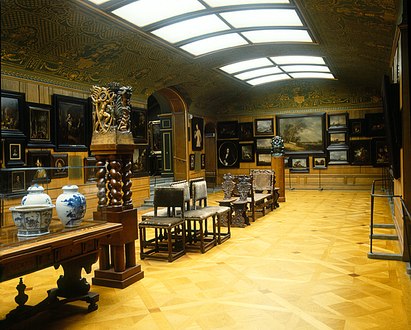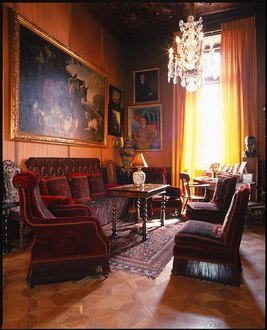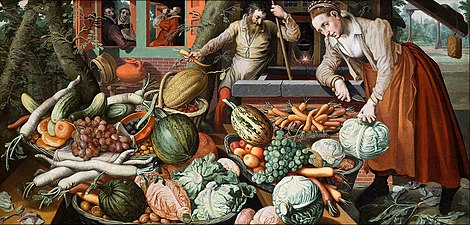Hallwyl Museum
- View a machine-translated version of the Swedish article.
- Machine translation, like DeepL or Google Translate, is a useful starting point for translations, but translators must revise errors as necessary and confirm that the translation is accurate, rather than simply copy-pasting machine-translated text into the English Wikipedia.
- Consider adding a topic to this template: there are already 314 articles in the main category, and specifying
|topic=will aid in categorization. - Do not translate text that appears unreliable or low-quality. If possible, verify the text with references provided in the foreign-language article.
- You must provide copyright attribution in the edit summary accompanying your translation by providing an interlanguage link to the source of your translation. A model attribution edit summary is
Content in this edit is translated from the existing Swedish Wikipedia article at [[:sv:Hallwylska museet]]; see its history for attribution. - You may also add the template
{{Translated|sv|Hallwylska museet}}to the talk page. - For more guidance, see Wikipedia:Translation.
Hallwyl Museum (Swedish: Hallwylska museet) is a Swedish national museum housed in the historical Hallwyl House in central Stockholm located on 4, Hamngatan facing Berzelii Park. The house once belonged to the Count and Countess von Hallwyl, but was donated to the Swedish state in 1920 to eventually become a museum. In 1938, the museum was officially opened.
History
Hallwyl House (Swedish: Hallwylska palatset) was built 1893–1898 to the design of Isak Gustaf Clason for Count Walther von Hallwyl [sv] and his wife, Wilhelmina. It was created to accommodate the office of the count and the extensive art collection of the countess. Wilhelmina and Walther von Hallwyl also lived there during the winter. While the exterior of the building and the court is historical in style — borrowing architectural elements from medieval prototypes and Renaissance Venice — it was utterly modern on its completion — including electricity, central heating, telephones, and bathrooms. The elevator was a later addition.
The countess collected her artworks during her worldwide journeys in order to found a museum, and, consequently, the palace was donated to the Swedish State in 1920, a decade before her death. The museum, including many of the rooms where they used to live, opened in 1938 to the public.[1]
Hallwyl Museum, in association with Skokloster Castle and the Royal Armoury, is part of a government agency known as the Royal Armoury and Skokloster Castle with the Hallwyl Museum Foundation, or Livrustkammaren och Skoklosters slott med Stiftelsen Hallwylska museet (LSH) in Swedish.[2]
Collections
Hallwyl House was donated to the Swedish state on the condition that it would remain unchanged. Today, the house has been preserved as it was when Countess von Hallwyl donated the house. The museum features preserved rooms from the late Victorian period in Sweden giving a glimpse into the lifestyles of the nobility in Stockholm at the time.[3]
The Hallwyl Collection, which is housed there, encompasses some 50,000 objects.[4]
-
 The silver room
The silver room -
 The gallery
The gallery -
 The kitchen
The kitchen -
 The smoking room
The smoking room -
 Christmas at the museum
Christmas at the museum -
 The dining room
The dining room
Gallery
-
 Jan Griffier
Jan Griffier -
 Pieter Aertsen
Pieter Aertsen -
 Pieter Brueghel the Younger
Pieter Brueghel the Younger
-
 Thomas Wyck
Thomas Wyck
See also
References
- ^ "The Hallwyl House". www.hallwylskamuseet.se. Retrieved 10 October 2014.
- ^ "A government agency". www.hallwylskamuseet.se. Retrieved 10 October 2014.
- ^ "The Hallwyl House". www.hallwylskamuseet.se. Retrieved 11 October 2014.
- ^ "Edwardian England on display in Stockholm". www.thelocal.se. Retrieved 11 October 2014.
- Johan Mårtelius (1999). "Norra innerstaden". Guide till Stockholms arkitektur (2nd ed.). Stockholm: Arkitektur Förlag AB. p. 93. ISBN 91-86050-41-9.
External links
- Official website
- Virtual tour of the Hallwyl Museum provided by Google Arts & Culture
 Media related to Hallwyl Museum at Wikimedia Commons
Media related to Hallwyl Museum at Wikimedia Commons
- v
- t
- e
- ABBA: The Museum
- Artipelag
- Biologiska museet
- Dansmuseet
- Lightship Finngrundet (1903)
- Fotografiska
- Hallwyl Museum
- Hamn (museum)
- Jewish Museum of Sweden
- Junibacken
- Konstnärshuset
- Långholmen Prison
- Liljevalchs konsthall
- Livrustkammaren
- The Maritime Museum
- Medelhavsmuseet
- Millesgården
- Moderna Museet
- Museum of Ethnography
- Museum of Far Eastern Antiquities
- Museum of Medieval Stockholm
- Nationalmuseum
- Nobel Prize Museum
- Nordic Museum
- Stockholm Observatory
- SS Orion
- Royal Coin Cabinet
- Skansen
- Spårvägsmuseet
- Museum of Spirits
- Stockholm City Museum
- Stockholm County Museum
- Stockholm Music Museum
- Stockholm Palace
- Strindberg Museum
- Sven-Harry's Art Museum
- Swedish Army Museum
- Swedish Centre for Architecture and Design
- Swedish History Museum
- Swedish Museum of Natural History
- Swedish Museum of Performing Arts
- Swedish National Museum of Science and Technology
- Thiel Gallery
- Toy Museum Stockholm
- Vasa Museum
- Villa Lusthusporten
- Waldemarsudde






















